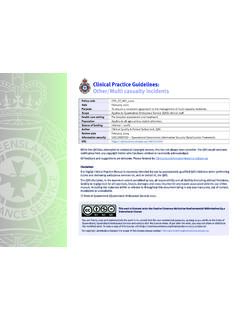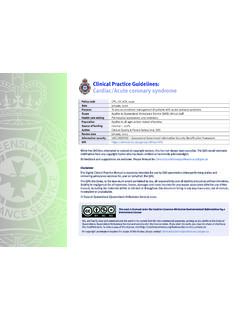Transcription of Clinical Practice Guidelines: Other/The bariatric patient
1 While the QAS has attempted to contact all copyright owners, this has not always been possible. The QAS would welcome notification from any copyright holder who has been omitted or incorrectly acknowledged. All feedback and suggestions are welcome. Please forward to: The Digital Clinical Practice Manual is expressly intended for use by appropriately qualified QAS clinicians when performing duties and delivering ambulance services for, and on behalf of, the QAS. The QAS disclaims, to the maximum extent permitted by law, all responsibility and all liability (including without limitation, liability in negligence) for all expenses, losses, damages and costs incurred for any reason associated with the use of this manual, including the materials within or referred to throughout this document being in any way inaccurate, out of context, incomplete or unavailable. State of Queensland (Queensland Ambulance Service) work is licensed under the Creative Commons Attribution-NonCommercial-NoDerivatives International LicenseYou are free to copy and communicate the work in its current form for non-commercial purposes, as long as you attribute the State of Queensland, Queensland Ambulance Service and comply with the licence terms.
2 If you alter the work, you may not share or distribute the modified work. To view a copy of this license, visit copyright permissions beyond the scope of this license please contact: codeCPG_OT_TBP_0221 DateFebruary, 2021 PurposeTo ensure a consistent appproach to the management of the bariatric to Queensland Ambulance Service (QAS) Clinical care settingPre-hospital assessment and to all ages unless stated of fundingInternal 100%AuthorClinical Quality & patient Safety Unit, QASR eview dateFebruary, 2024 Information securityUNCLASSIFIED Queensland Government Information Security Classification Practice Guidelines: Other/The bariatric patient 394 QUEENSLAND AMBULANCE SERVICEThe bariatric patientBariatric patients are increasingly entering the healthcare system; these patients require special consideration in relation to unique safety, mobilisation, transport and Clinical care issues. failure to adequately address these considerations may place the patient and clinicians at increased risk of injury and World Health Organization (WHO) lists the extent of the obesity epidemic as one of the world s most significant health problems.
3 [1] As the numbers of morbidly obese patient encounters increase, the rate of specific chronic health conditions will also who are morbidly obese are at a significantly higher risk for developing chronic diseases including: cardiovascular disease type II diabetes hypertension kidney stones stroke / transient ischaemic attack pulmonary disease osteoarthritis psychiatric disorders physical disabilities; and premature the individual s weight increases, the Body Mass Index (BMI) increases and the risk for comorbidities also to a combination of mobility issues, transport obstacles, embarrassment or fear of being treated poorly by healthcare providers, bariatric patients will often delay seeking treatment until their illness has significantly progressed. The key to effective and safe patient handling is to realise that many patients struggling with obesity experience psychological, physiological and medical challenges.
4 [2] Obesity bias is not spoken of to the degree that other demeaning actions such as abuse, bullying, profiling, discrimination and other issues that bring intolerance to light. The reality is, however, that obesity bias is just as debasing as any other form of ostracism. Displays of bias span the range from subtle actions like eye-rolling, voice intonation, and facial movements to overt inconsideration, disrespect, and disregard. All can lead to devastating physical and psychological effects. Clinicians must anticipate and address problems that may interfere with optimal patient care, safety, and human dignity. Professionalism and compassion are always essential [2]February, 2021 Figure UNCONTROLLED WHEN PRINTED UNCONTROLLED WHEN PRINTED UNCONTROLLED WHEN PRINTED UNCONTROLLED WHEN PRINTED395 QUEENSLAND AMBULANCE SERVICE Clinical featuresBariatric patients have additional needs that require clinicians to be cognisant of challenges that accompany the care of these patients, including: Increased upper airway resistance, extra adipose weight on the chest, and redundant supraglottal tissue making difficult face mask ventilation even more difficult.
5 [2] Large thick tongues, short thick necks and redundant adipose tissue distorting neck anatomy. An enlarged heart due to the excess strain of oxygenating the body s expanse of tissues. Hypoventilation is a typical finding on bariatric patients caused by impaired chest expansion related to an inability for the diaphragm to fully move down during inhalation.[2,3] These patients are relatively hypercapnoeic and may worsen with any illness or intervention which reduces respiratory ventilation functioning. Rapid patient oxygen desaturation is a frequent occurrence due to decreased functional residual capacity. Breath sounds are commonly distant or difficult to auscultate on the chest. Clinicians should listen for breath sounds on the patient s back just medial of each scapula where a lower density of adipose tissue interferes less with auscultation. Cyanosis is often best assessed by examining the inside of the patient s eyelid or lips.
6 Clinical features (cont.) Cannulation difficulties due to thick layers of adipose tissue obscuring deep veins from visualization and/or palpation and distortion of normal landmarks. Risk assessment If appropriate, position the conscious patient to facilitate lung expansion and decrease risk of positional asphyxia. This may be required even in acute trauma as this group of patients do not tolerate supine positioning. Consider Ramping the patient by placing several pillows or blankets under the head, shoulders (and possibly torso) to align the ear with the level of the sternal notch. Ramping assists airway management by optimising upper airway patency, laryngoscopy view and mechanics of ventilation. [4] Ramping of patientUNCONTROLLED WHEN PRINTED UNCONTROLLED WHEN PRINTED UNCONTROLLED WHEN PRINTED UNCONTROLLED WHEN PRINTED396 QUEENSLAND AMBULANCE SERVICE Risk assessment (cont.) Typical testing sites for blood glucose monitoring like a patient s finger may not provide enough blood due to thickened fat pads.
7 An alternate site that may be more successful at rendering an adequate sample is an earlobe.[2] Typically, pulse oximetry readings are calculated from a patient s index finger. However, if the patient has dense thick fingers light wave transmission may prevent a good wave form. An alternative may be to place the probe on the smallest available finger, lip, or earlobe. bariatric patients typically have a difficult airway which is defined as having difficulty with face mask ventilation of the upper airway, difficulty with tracheal intubation or both ;[3] Two person BVM techniques will commonly be required to elicit adequate airway and ventilatory control one clinician uses both hands to perform bilateral jaw thrust while the second clinician ventilates the patient . Consider early use of an adjunct airway device as indicated. Given that venous access is difficult to obtain in the bariatric patient , clinicians should analyse the benefits of obtaining access prior to transport based on the patient s presentation and transport time to hospital and consider;- IV access may be easier to establish using ultrasound guidance at the receiving hospital;- Consider the use of intraosseous insertion; and- Consider alternative routes for medication administration including intramuscular (IM) and intranasal (IN) routes.
8 Caution when administering pharmacology is prudent as any drug with potential cardiovascular and respiratory depressant effects must be used with caution in obese patients whose physiologic reserve is WHEN PRINTED UNCONTROLLED WHEN PRINTED UNCONTROLLED WHEN PRINTED UNCONTROLLED WHEN PRINTED397 QUEENSLAND AMBULANCE SERVICE Additional information Most clinicians work in teams of two. It is acknowledged however that some clinicians do work as single responders but rarely can two people safely transport a patient that is morbidly obese, even if that patient can assist. It is crucial that clinicians are adept and adhere to proper lifting techniques, with the plan of extrication communicated and understood by all involved prior to any lifting taking place. The most essential element in the safe transport of a bariatric patient is communication. Early notification of the requirement for an additional resource is mandatory.
9 The use of lifting aids is mandatory, however under no circumstances is lifting equipment to be used by persons who are not trained in its operation. It is important for all lifting efforts to include all possible means to preserve the patient s privacy, dignity, and comfort. Practice drills should be implemented to aid in familiarising all responders involved in the extrication prior to any lift taking : Clinician safetyCPG: Standard caresTransport to hospitalPre-notify as appropriateManage as per CPG:Specific to pathologyNote: Clinicians must only perform procedures for which they have received specific training and authorisation by the WHEN PRINTED UNCONTROLLED WHEN PRINTED UNCONTROLLED WHEN PRINTED UNCONTROLLED WHEN PRINTED











